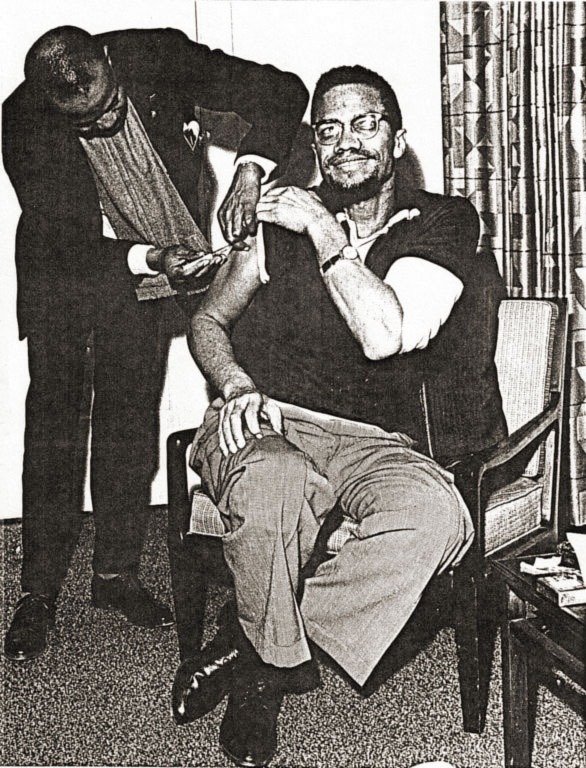
This is a photograph of my uncle Dr. Evans giving Malcolm X a shot for exhaustion when he arrived in Detroit in 1965 to speak at an Awards program, after his house had been firebombed. I was a freshman at Wayne State University. I did not go to hear him this time. I can remember no good reason. I had some school work? My father, Rev. Albert B. Cleage Jr. gave the invocation before Malcolm X’s speech.
My sister Pearl did attend and she remembers it like this:
“I did go to this speech. Malcolm looked exhausted and worried. We were worried for him and for his wife, Betty, and their children. When things like that fire bombing happened, they always made me worry about my father. being the child of an activist parent makes you proud, but scared for their safety. whew. lots of memories came with this one…”
My friend, historian Paul Lee, contextualizes the photograph of Malcolm X getting a shot below in an email dated Jan. 25, 2004.
Click on the photographs to enlarge. Ford program scans courtesy Christopher Chatman.
As promised, please find attached a scan of an image of your aunt Gladys’s late husband, Dr. E. Warren Evans, administering a sedative to Malcolm X during the early afternoon of Sunday, 14 Feb. 1965.
It was shot in Malcolm X’s room at the old Statler Hilton Hotel when he visited Detroit to deliver what turned out to be his “Last Message,” as the posthumously-released long-playing record of it was titled by attorney Milton Henry, his good friend, who taped it.
At the time, Henry was the president of the 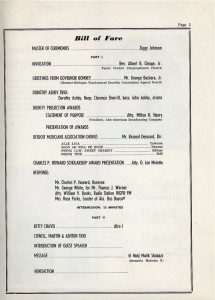 Afro-American Broadcasting and Recording Company and, along with his brother Richard Henry, was a leader of the militant Group on Advanced Leadership (GOAL). He invited Malcolm X to Detroit to receive an award at the “First Annual Dignity Projection and Scholarship Awards” ceremony, which was held at Ford Auditorium on the city’s waterfront.
Afro-American Broadcasting and Recording Company and, along with his brother Richard Henry, was a leader of the militant Group on Advanced Leadership (GOAL). He invited Malcolm X to Detroit to receive an award at the “First Annual Dignity Projection and Scholarship Awards” ceremony, which was held at Ford Auditorium on the city’s waterfront.
You will note that the exhausted-looking Malcolm X is wearing an open-neck sweater instead of his traditional white shirt and thin straight tie. This is because his home had been firebombed by Elijah Muhammad’s Nation of Islam at around 2:45 that morning and, as he noted in his talk, most of his clothes had been damaged 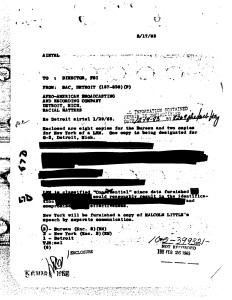 by the smoke.
by the smoke.
Malcolm X, who was then the president of the black nationalist and Sunni Islamic Muslim Mosque, Inc. (MMI) and chairman of the pan-Africanist Organization of Afro-American Unity (OAAU), was assassinated almost precisely one week later.
HOOVER’S HANDICAP
When Malcolm X made his last visit to the city, the Detroit FBI office decided to let the local spooks do the heavy lifting. They had at least one good reason for doing so: The cops had the advantage of using 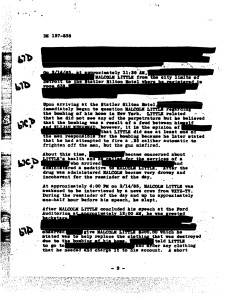 “black” undercover agents and Malcolm X, unlike Dr. King, usually moved in all-“black” circles.
“black” undercover agents and Malcolm X, unlike Dr. King, usually moved in all-“black” circles.
Of course, the anti-“black” Hoover refused to hire and
train “black” agents until the escalating pace of the civil-rights and black-power movements, along with pressure applied by his intelligence-hungry superiors, forced him to do so.d
CALLING DR. EVANS, CALLING DR. EVANS
Following are excerpts from the 17 Feb. 1965 summary of the report made by local police, which 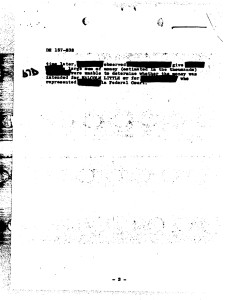 they provided to Special Agent Thomas J. Robinson, who handled “racial matters,” including black nationalists. Presumably, it was Robinson who was responsible for surveilling and attempting to undermine your father, who was then still known as the Rev. Albert B. Cleage, Jr.
they provided to Special Agent Thomas J. Robinson, who handled “racial matters,” including black nationalists. Presumably, it was Robinson who was responsible for surveilling and attempting to undermine your father, who was then still known as the Rev. Albert B. Cleage, Jr.
It is unclear WHICH department provided the intelligence–that is, the city or state police–because the Freedom of Information and Privacy acts (FOI/PAs), which compel the release of government documents, also allow certain “exemptions,” including, amazingly, “personal privacy”–which protects their officials, agents and snitches from being revealed–and “confidential” or “national security” sources, such as the police and other intelligence agencies:
“On 2/14/65, at approximately 11:30 AM, [passage withheld on confidential-source grounds, but it refers to the Detroit Police Department, which escorted] MALCOLM LITTLE from the city limits of Detroit to the Statler Hilton Hotel where he registered in room 638…
“About this time, [name withheld on personal-privacy grounds, but MILTON HENRY] became concerned about LITTLE’s health and he called for the services of a [name withheld, but DR. EVANS,] who arrived [passage withheld] and administered a sedative to MALCOLM LITTLE. After the drug was administered MALCOLM became very drowsy and incoherent for the remainder of the day.
“At approximately 4:00 PM on 2/14/65, MALCOLM LITTLE was awakened to be interviewed by a news crew from WXYZ-TV. During the remainder of the day and to approximately one-half hour before his speech, he slept” (SAC [Special Agent in Charge], Detroit FBI [by Special Agent Thomas J. Robinson] airtel [air telegram] to Director, FBI, “Afro-American Broadcasting and Recording Company, Detroit, Mich.; Racial Matters,” Feb. 17, 1965, in FBI headquarters file on Malcolm K. Little, 100-399321-not recorded, but after serial 228.
By the way, this report tends to confirm that, several hours before Malcolm X spoke (around 10:00 that evening), the effects of the sedative had abated. After all, he couldn’t have given an interview to Channel 7 that afternoon if he was still “incoherent.”
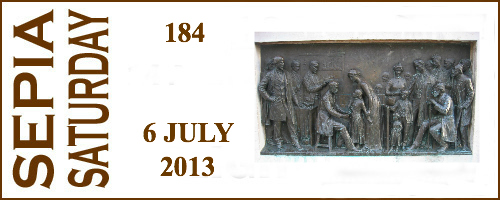

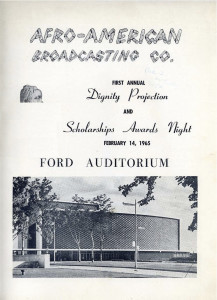
I can imagine he was exhausted, body and mind. His home was firebombed, threatening his life and the life of his wife and children. The enemy was all around including people who thought he could trust. Good to know he got a brief relief…Wonderful historical photo.
I wish I had a better copy but am so glad to have this one.
You were always so close to history-making people and events that I can see you shaking off Malcolm X’s appearance nonchalantly, somewhat “been there, done that.” Any regrets?
If it had been the only time I had a chance to hear him and I hadn’t gone, I would regret it, but it wasn’t. It was so long ago. If I went back in time, I would go this time, but not really any regrets.
Oh my goodness, Kristin. You and your family have certainly made history! What a terrific photo, one that humanizes Malcolm and reminds us what stress he must have been under at that time. I will listen to his last speech–thank you very much for posting the link. (And not meaning to sound flippant about such a serious subject, but your story uses “shot” in two different senses (injection, photograph), which sound ominous when one knows that a third kind of shot was to end his life just a week later.)
That thought about the ‘shot’ did cross my mind. I almost changed the title.
Hi Kristin, this is my first time commenting on your extraordinary blog. I enjoy your stories and pictures immensely. Thank you for sharing them with us. Did you know that you can sign up for a Wikipedia account and edit your father’s details on his page?
I did know that, but I’ve just never taken the time to do it.
Thanks for all this fascinating information. As usual your post makes me hungry for more. I often wonder about my own ridiculous concerns during this important time period – we didn’t realize how important these events were. Your father was a an amazing man…are the Wikipedia “facts” about his life accurate?
I don’t know. Guess I should go read it and report back.
Just read the wikipedia entry. The following (at least) are incorrect:
1. He had no identity crisis regarding being a light skinned and black.
2. He was a minister in San Francisco before going to study film in Los Angeles. He left there to go to Springfield, MA.
3. St. Marks United Presbyterian Church in Detroit was not interracial, it was all black. The split resulted from disagreement between some of the older members, including his uncle Henry Cleage and himself about the role of the church in the community.
4. The Illustrated News was not a church published tabloid, it was published by his brother Henry Cleage and other family and friends outside of the church.
This is a most interesting post. Of course the name Malcolm X rings bells with me, but actually that is almost all. I really know nothing. I am going to follow this up and understand who he was, and the context he I don’t want to be so blatantly caught out with my ignorance again. But you understand that it was hard for a boy aged 10-20, as I was, in the 1960s, to follow US civil rights and Vietnam war etc etc… there was so much we had to learn in those 10 years.
I certainly understand. There is much about what was going on in other places that I don’t even know I don’t know yet. The perfect time to learn more is when you realize there is more to learn and have the desire to follow up.
Always fascinated by the things you share! I was 12 and living on the prairies of Kansas. I could have been across an ocean for all I knew about what was going on. I guess I heard things on the news, but it was not like the 24-hour non-stop news of today and it seemed like it was happening in another world to an insulated kid like me.
It would be interesting to have a prompt that picked a season and a year and all of us could write about what we were doing, where we were living, at that time.
Your stories always have such fascinating details which makes for good writing and great history. Learning the background to photos like this makes the history personal and shares a common humanity.
I saw the film about Malcolm X starring Denzel Washington, but the original events passed me by as I was only four and living half a world away. It’s good to hear some behind the scenes snippets too.
Wonderful photo full of history. Thanks for the story.
Oh my gosh, Kristin, you have another treasure here. To know that your Dad gave the introduction speech and that you could have gone to see Malcom X’s last speech but were busy with something else is something.
What a wonderful piece of history. Thanks for pulling it all together for us.
Kathy M.
I didn’t really know anything about Malcolm X. I thought he was more radical–like the lady he met on the plane thought. I was surprised that he sounded so cool, calm, intelligent and intelligible.
He always sounded that way. You just don’t get the real picture by reading or listening to main stream news. Then or now.
Amen to that!!!
😀
HUGZ
You never cease to amaze me with the wealth of information you have which is linked to historic events. Your sister having attended brings a really personal touch.
The whole family probably attended, except me.
Kris,
Thank you for the share. Interesting information to accompany a photoI know oh to well.
Always happy to spread the information.
VERY ENLIGHTNING!!!!!
Great, remarkable, history making photos. You come from a family rich in history, how lucky you are.
Amazing. You are sharing so much with us. And broadening my view of the world then.
Another excellent post, Kristin. Wow. Just wow. To be so close to such major events in the country’s history is a family heritage to be proud of.
I am so glad you are blogging all of these things. Kids text books are so general. It is fascinating to see how these events touched the lives of different people in different communities.
All old photographs touch history. With most of them, that touch is second-hand, the photo reminds us of styles or habits or occupations. But with some that touch is first hand, bringing us face to face with people who had a massive impact on our current world. The picture you feature this week is just such a photograph; thank you so much for sharing it with us.
A fascinating piece about a man we had all heard of but considered what was happening had now effect on us. To be so close to these events must have been inspiring. Thanks, Kristin.
Excellent photo and post!
Absolutely fascinating. Personal stories and connections to history make it come alive. Thank you for this.
I’m just amazed (along with all the other Sepians) about how close you and your family have been to so many history making events. That photo is really special.
Nancy
Amazing shot here, as usual!!
You had your Civil Rights Movement,
we had our “Revolution Tranquille”,
which wasn’t always SO quiet…
I may have been somewhat young back then
but such things were discussed at home.
I wasn’t raised in naivety and knew about the plight of others.
You give history a more intimate look
and I am grateful to you for that.
:)~
HUGZ
I didn’t know it was called Revolution Tranquille. I remember listening to the news on the Canadian radio station in the 1960s and early 1970s. Things were happening all over. As they are now.
Hi Kristin~
My name is Alamaze & I grew up as a baby in the Shrine. Im currently researching & finding FASCINATING facts regarding my paternal side of my family. Jaramogi & I had a special relationship when I was a child. One that has completely made me WHO I am & personally the reason I pick men well, lol! (He became the standard)!
I recently found out my great grandfather Rev. Marshall A Talley was the only elected black in the House of Representatives in 1937 in the State of Indiana. His son, my grandfather the Rev. Cornell E. Talley was the minister of Central Baptist church eventually changing it to New Light Baptist Church in Detroit. I wish i could just ask Jaramogi if he knew them but thats not possible. I was wondering if you or your remaining family recall those names. If Rev. Dr. Albert Cleage SR. & my great grandfather Rev. Dr. Marshall Talley were both prominent members in their communities, surely they mustve known each other? I am committed to connecting the dots. Your help is greatly appreciated!
I’m sorry, I don’t know any way to connect those dots.
Hi Kristin,
My dad was with them the day that photo was taken. Dad used talk about that day a lot. I remember he told me that they wanted to call your uncle Louis, but he was in Idlewild, so they called Dr. Evans to administer the shot. Dad took photos at the speech too, but the film was exposed and none of the pictures came out; he always said that one his greatest regrets….
I can imagine that would have been very depressing, losing those photographs. Walter Knall was with Louis in Idlewild and remembers the day from the other end.